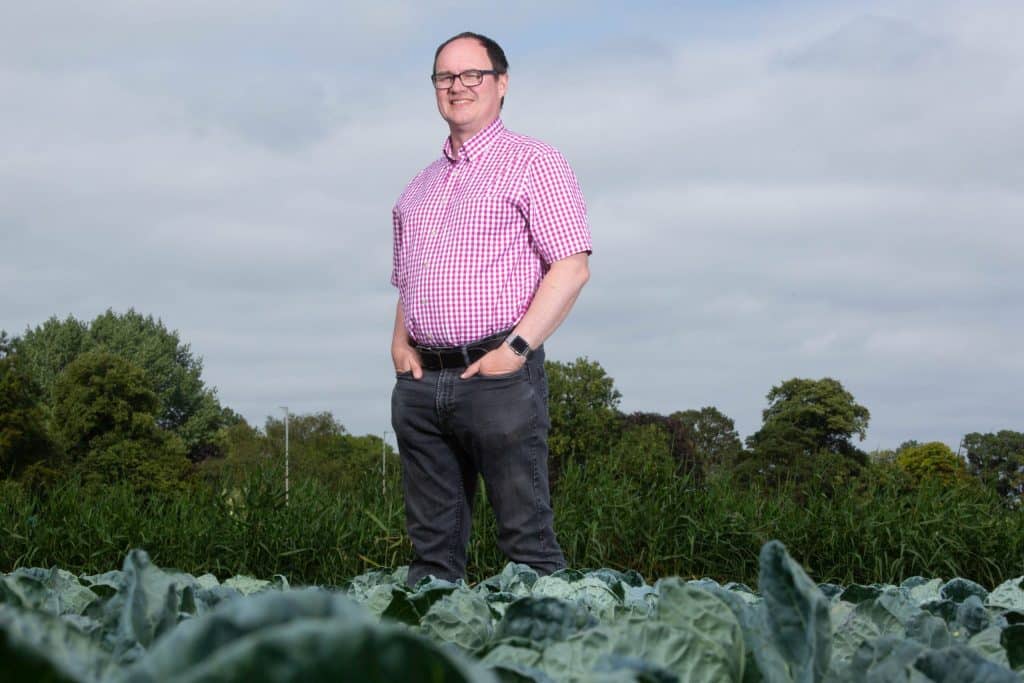Fine-tuning your nutrition strategy – The Vegetable Farmer – Tim Kerr, Peter Waldock
Calcium, phosphate and sulphur all play a crucial role in healthy plant growth across all vegetable crops ...
Heather Briggs talks to Hutchinsons crop nutrition manager Tim Kerr and technical support for vegetables, Peter Waldock to find out some of the key facts driving good nutrition strategy decisions.
Improving turgidity, strength and health, calcium has a fundamental role in the development of strong cell walls, which are less likely to be invaded by pathogens, says Tim. A healthy plant needs good structure – and that is what calcium helps to provide. In addition, it contributes to storability because of its role in cell membrane structure helps to retain moisture, which can help to reduce storage losses.
If there are insufficient calcium levels in the cell when a plant goes through a growth spurt, the cell walls can become weaker and burst, resulting in necrosis and browning. In maize, deficiency is shown as twisting of leaves, whereas in brassicas it is a contributor to club root, and in lettuce it is also a consequence of available calcium not reaching the outer leaves.

Tim Kerr
Peter says: “For crops from pumpkins to leafy salads, it is crucial to build a good cell structure, so the crop has the maximum shelf life possible.
Deficiency in crops can mean growers pay a heavy price, warns Tim.
Calcium is often overlooked in the UK as it occurs naturally in the soils and is the dominant exchangeable cation even in low pH soils, but this does not necessarily mean that it is always plant available when required. Unlike more mobile nutrients such as nitrogen, plants cannot mobilise calcium to cope with transient shortages. This is the primary reason that symptoms of calcium deficiency are seen first at the growing point or younger leaves.
“Getting calcium into the plant can be challenging as it has to enter through the roots, but if conditions are too dry or too wet – availability can be compromised. More extreme weather events in Britain only serves to increase this risk.”
In potatoes, insufficient calcium at tuber initiation can lead to internal rust spots, and although immature tubers can absorb some calcium, this can be too late, notes Tim. Certain varieties are more prone to IRS – and risk management is important in trying to minimise the chance of IRS causing quality issues.
“Free-draining sandy soils are more prone to leaching, and after wet winters like 2020 it is likely you have lost a lot of nutrients from the rooting zone. Also, if your soils tend to be on the dry side, a soil test is a good idea, and if necessary precautionary applications can be applied. It is better to act prophylactically than risk deficiency because calcium is not mobile in the plant.”
There is sometimes a misconception that liming materials will supply enough calcium for the crop in the year of application, however liming materials are mainly calcium carbonate based and therefore not very soluble.
This means that the calcium from lime may not be readily available through the growing season to a crop such as brassicas.
He advises that applications of calcium are best done as calcium nitrate, which provides both readily available nitrate nitrogen and calcium to the growing crop and unlike ammonium nitrate, does not risk scorching tender plants.

Peter Waldock
Peter notes that calcium can be applied as a foliar spray, but foliar feeding also can have mixed results as the Calcium molecules in many foliar products are too large to move from cell to cell within the plant. Potassium (K) and sulphur are key to well-flavoured, good quality vegetables. Potassium drives cell turgor and, therefore helps the plant produce the firm tissue necessary for a crop which not only looks good but also has maximum shelf life and flavour.
The problem is that vegetables are often grown on light, free-draining soils, which tend to be deficient in K. “Ensuring there are adequate supplies in the soil is crucial as demand is large and the crop can use between 30- 50kg/ha a week during peak uptake.”
Peter explains that if it is in short supply, the stomata pumps do not work properly and the plant cannot respire and photosynthesise, Potassium availability is also key for nitrogen fixing bacteria in to work well in legumes. Sub-optimal levels can affect root rot type problems, such as blackleg (such as those caused by Erwinia spp), and Peter has seen some anecdotal references to root knot nematode damage.
He notes that because of the very dry period when establishing crops this year there were several examples of potassium deficiency in the field which shows up as lower leaves having bright dark yellow edging which then go necrotic.
“This is likely to have been due to the lack or water osmotic process to pull the nutrient out of the ground,” he says. “You can apply it as a foliar feed, but most foliar feeds have low levels of K as it is generally considered as a base nutrient.”
The two emphasise that balancing the nutrients is important in many crops, and potassium magnesium and calcium interact with inter cellular transport.
Tim says: “If your soil is very high in magnesium, which is necessary for chlorophyll and photosynthesis, this can lead to imbalances in potash uptake.
Peter adds: “Working to the RB209 recommendation tables and a current soil test is important to make sure you add the appropriate dressings to the field before planting”
Sulphur is also an essential secondary nutrient needed by vegetables and plays a key role in producing the long-chain amino acids critical to growth. “It provides what is effectively the mortar needed to hold the bricks together,” says Tim.
Peter agrees, noting that this is because the right level of sulphur stimulates the metabolic process to make cells stronger and more able to resist pathogens. “When the correct amount of sulphur is present, the plant releases sulphur compounds as a defence mechanism, making it more resistant to fungal spore germination.”
Brassica varieties, in particular, have a high requirement, which also used to contribute more to the flavour complexities, but recent changes in genetics have resulted in naturally sweeter varieties. One of the challenges is that deficiency is sub-clinical, and if left untreated, growers are then left with lower yields.
Tim says: “We know that since the Clean Air Act, sulphur deposits from the atmosphere have been lower. As it does not stay in the soil it is a good idea to apply sulphur to Brassicas at a rate of 3 parts nitrogen to 1 of sulphur every year to ensure that crops have sufficient for their needs.”
Peter adds that sulphur and nitrogen are interlinked, and for the nitrogen to be used by the plant, sulphur needs to be present. “Many growers will include sulphur within their nitrogen base dressing, especially if you need crop hardiness and turgidity in winter.”
There are also now several sulphur-based fungicides such as Microthiol Special (80% W/W Sulphur) from UPL and when it is acts as a fungicide, sulphur can help prevent downy mildew, powdery scab, and also soft rots caused by Erwinia bacteria.”
Interactions between crop nutrients highlighted
Peter points out that every crop has different interactions with minerals, even within a cultivar (variety).
“Care needs to be taken to ensure the right proportions of each are available; for example, too much calcium is as bad as not having enough,” he warns.
This is because the calcium can limit uptake of phosphate, leaving the crop short.
“If you look at the Mulders diagram, which is based on standard soil science, you can see which facilitate the uptake of others, and those which limit it.”